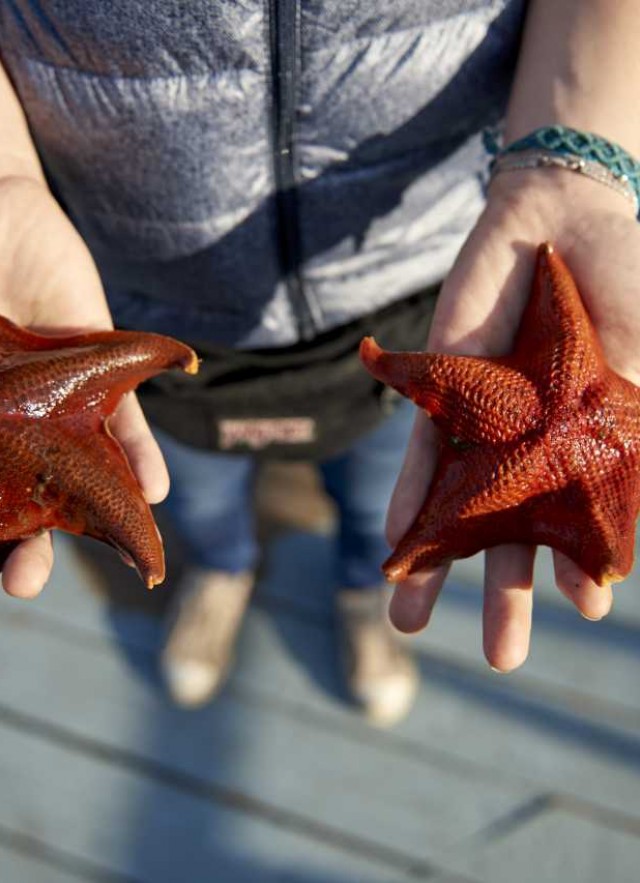Oceans Online
Digitization of collections unlocks climate clues.

Let’s just say—you know, for argument’s sake—that you have millions (seriously though, millions) of specimens on shelves, in jars, on your desk—wherever!—that document the history of biodiversity of the Southern California coast for the last, oh, million years give or take a few hundred thousand. What would you do with them?
Keep in mind that this hypothetical collection of living or fossil animals—crabs, clams, octopuses, snails, shrimp—are a record of biodiversity over time. Their little bodies hold nearly endless information about how the animals lived and what their surrounding environment was like. The data from such collections could be used to investigate current and past climate change, inform today’s conservation efforts, understand the slow march of evolution, and inform policy and education decisions. But they can’t do much of that if they continue to sit on your shelf where no one but you can access them. This is the situation in our collections at NHMLA. Many of our marine invertebrate collections were collected over the past 100 years— before computers and printers— and have only handwritten labels. These specimens from our California coast today and the recent past represent everything from snails, octopuses, crabs, sea stars, jellies, worms, and sponges. And Invertebrate Paleontology has some of the same invertebrate organisms but in fossil form: crabs from 10,000 years ago to snails from many millions of years ago. Researchers in these collections are pursuing rigorous digitization efforts, using state-of-the-art equipment and old-fashioned elbow grease to comb through the many drawers and cabinets full of specimens and bring these creatures into the light of the 21st century. This means photographing them, transcribing their labels—some of which have 100- year-old cursive—and entering the coordinates of their original location into public electronic databases.
The same is done for the many incoming specimens to these collections, whether it’s a fossil or a fan worm. Researchers in our Diversity Initiative for the Southern California Ocean (DISCO) regularly collect new marine invertebrates from tidepools, boat docks, and the open ocean. These new specimens are not only digitized but also sampled for DNA. Their unique sequences are added to the International Barcode of Life Database, so we not only share photos of these animals but their genetic fingerprints as well.
LITTLE BOTTLES, BIG DATA
With the cloud of climate change overhead, researchers are in a race against time to make this data accessible as soon as possible, for among these fossils, shells, and crawling critters could be much needed clues about climate change. What were the tipping points in past climate changes? How quickly did certain species go extinct? And how are our current marine invertebrates faring in this changing climate? We’re trying to document a system that is in flux, so it’s as if the goal posts are constantly moving. The sense of urgency is palpable.
“Although we’ve been accumulating museum specimens for centuries, the pace of climate change now means that, to make them useful, we need to digitize them within a decade,” says Regina Wetzer, Associate Curator of our Marine Biodiversity Center.
NHMLA is part of a larger effort by researchers the world over to understand our ecosystems now so that we can see how they are affected by climate change. Digitized data from museum specimens are being complemented by innovative remote sensing. NASA’s CORAL Mission (an acronym for COral Reef Airborne Laboratory), operated by the Jet Propulsion Laboratory in Pasadena, has similar goals, providing snapshots of coral health in the Great Barrier Reef and reefs in Palau, Mariana Islands, and Hawaii.
“CORAL offers the clearest, most extensive picture to date of the condition of a large portion of the world’s coral reefs,” says CORAL Principal Investigator Eric Hochberg of the Bermuda Institute of Ocean Sciences. “This new understanding of reef condition and function will allow scientists to better predict the future of this global ecosystem and provide policymakers with better information for decisions regarding resource management.”
With our climate changing faster every day, the scientific community is rushing to develop the global information we need to protect and manage our vulnerable ecosystems.